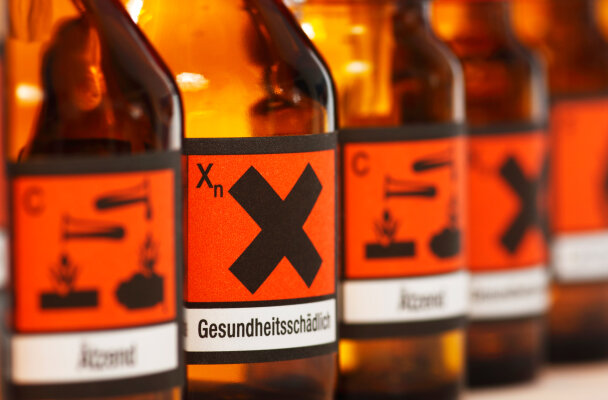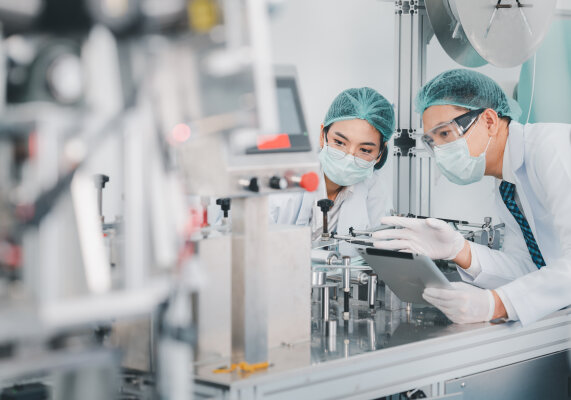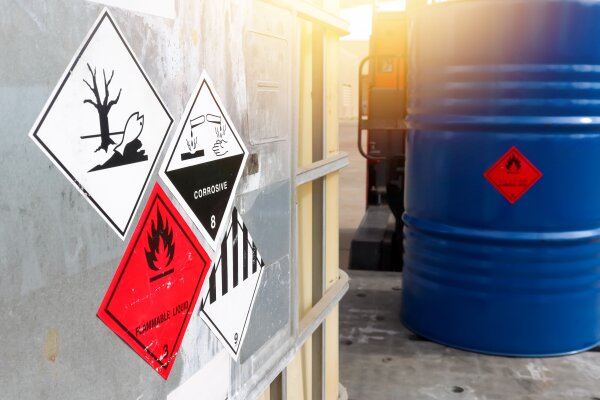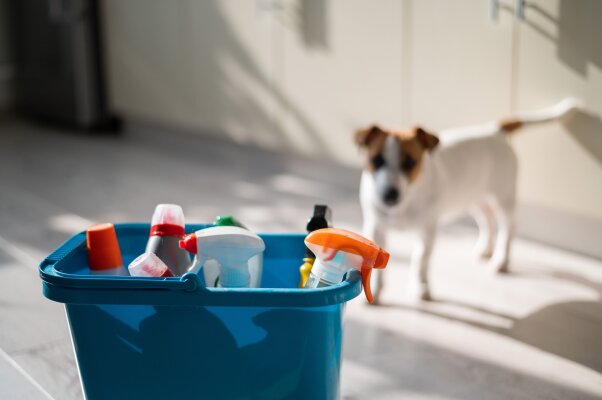Peroxide Hazardous material: all for hazard class 5
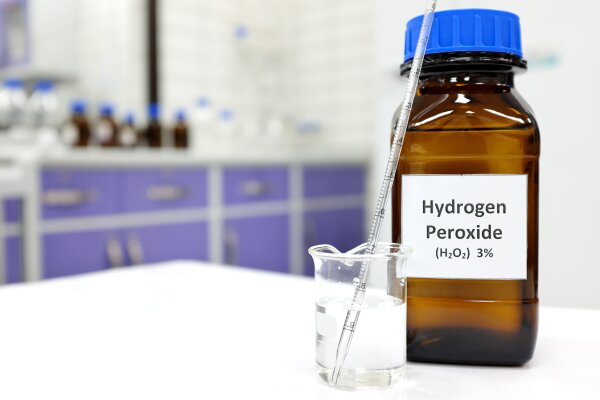
For safe transport, hazardous substances are divided into dangerous goods classes. Dangerous goods class 5 focuses on substances that have an igniting or oxidizing effect, whereby these are differentiated into two subclasses. In this blog post, we have summarized which substances belong to dangerous goods class 5, how the subclasses are divided, and what you need to pay attention to in terms of labeling and transport.
Flammable substances that do not burn themselves: Peroxide Hazardous material
When talking about substances of dangerous goods class 5, we are talking about flammable substances in liquid or solid form that pose a physical-chemical hazard. They can release oxygen and start a fire with other objects and substances. Because of this property, they are also referred to as oxidizing and fire-promoting. In contrast to dangerous goods class 1, however, they are not directly explosive.
According to the ADR class (European Agreement concerning the International Carriage of Dangerous Goods by Road), these dangerous substances are divided into flammable or oxidizing substances (hazard class 5.1) on the one hand and organic peroxides (5.2) on the other.
In everyday life, we encounter dangerous goods of this class all the time. Well-known representatives are, for example, pressurized gas packages, fertilizers containing ammonium nitrate and all organic peroxides containing more than 7% hydrogen peroxide.
Subclasses of hazard class 5
The goods of hazard class 5 are differentiated into two subclasses: namely hazard classes 5.1 and 5.2. For subclass 5.2 there is an additional differentiation into groups P1 and P2. These divisions are made according to specific properties of the substances, so that labeling, transport and storage can be adapted even more precisely.
Division 5.1 - Oxidizing agents
Class 5.1 dangerous goods are substances and materials which, although they need not be flammable themselves, may cause a fire by releasing oxygen or may have a fire-accelerating effect on other substances. They may contain flammable substances (think, for example, of ethyl alcohol and acetone) which, in combination with hydrogen peroxide, have an explosive or deflagrating effect.
Common representatives of hazard class 5.1 are oxygen, hydrogen, potassium chlorate and nitric acid. Fertilizers containing ammonium nitrate and sodium chlorate can also be assigned to this subclass.
Division 5.2 - Organic peroxides
Subclass 5.2, on the other hand, includes all organic peroxides that ...
- ... contain more than 1% active oxygen and more than 1% hydrogen peroxide
- ... or more than 0.5% active oxygen and more than 7% hydrogen peroxide.
In contrast to hazard class 5.1, this composition results in an additional risk of explosive reactions or stronger fire behavior when reacting with other flammable substances.
Examples include dibenzoyl peroxide (a hardener for polyester resin) and methyl ethyl ketone peroxide (a hardener for 2-component paints). Hazard class 5.2 can further be divided into two groups, in which criteria for temperature control are specified:
- P1: No temperature control is necessary
- P2: A temperature control must be carried out
Problem with transport and traffic
Because of their potentially explosive and deflagrating properties, special hazards arise during transport, so that special precautions must be taken. Some substances are even excluded from transport. It is therefore important to carry out a prior evaluation and to know the legally required labeling of dangerous goods class 5. In this way, it is possible to react quickly and correctly in the event of damage.
Peroxide Hazards Hazardous Materials
The greatest danger of dangerous goods class 5 comes from the fact that these representatives can supply oxygen for combustion -especially at higher temperatures and in combination with other substances, this can lead to detonation. If they come into contact with flammable substances, a fire and explosion hazard is created.
In addition, these substances are self-decomposing under the influence of heat and light and can trigger chemical reactions when combined with water and acids. In addition, there is the risk of toxic gases in the event of a fire. Since these hazardous materials release oxygen, conventional extinguishing agents are ineffective (foam, sand and carbon dioxide are ineffective here).
To contain the hazards during transport, some substances in hazard classes 5.1 and 5.2 must be subjected to temperature control. For this classification, they are assigned to types A to G:
| Type | Designation | Dangers |
| Type A | Organic peroxides | Detonation or deflagration in the packaging |
| Type B | Organic peroxides | These have explosive properties and are prone to thermal explosions in the packaging |
| Type C | Organic peroxides | These have explosive properties, but can neither deflagrate quickly nor explode thermally in the packaging |
| Type D | Organic peroxides | Show no violent or only medium effect in laboratory tests when heated under confinement and do not detonate at all or partially. They deflagrate slowly |
| Type E | Organic peroxides | Do not detonate and deflagrate in laboratory tests when heated under confinement and show little or no effect at all |
| Type F | Organic peroxides | These do not detonate in the cavitating state and do not deflagrate at all. Even when heated under confinement, they show little or no effect and explosive force |
| Type G | Organic peroxides | If organic peroxides of type F are additionally thermostable, they can be assigned to type G |
Promotion measures
The ADR Convention established several legal principles and obligations that apply to the transport of various classes of dangerous goods - and consequently also extend to representatives of dangerous goods class 5.
For example, truck drivers must acquire an ADR license in a training course and carry special equipment. In addition, there is a comprehensive set of regulations on classifications, packaging, labeling and documentation. You can find a comprehensive guide here, for example.
Substances that are not authorized for carriage
There are also some substances in this dangerous goods class that are not permitted for carriage at all. Not even if the above measures are met. These include in particular the following representatives:
- UN number 3100: This UN number covers solid substances which are considered to be flammable or oxidizing and capable of self-heating. In fact, some organic peroxides of types B to F fall into this category.
- UN number 3121: This includes flammable (oxidizing) solids that react with water.
- UN number 3137: These flammable (oxidizing) solids are flammable and capable of self-heating. However, those that meet ADR Class 1 regulations are exempt - they may still be transported.
- Non-stabilized hydrogen peroxide: If hydrogen peroxide is not stabilized as is, or if it is a solution consisting of more than 60% hydrogen peroxide, the substance is also excluded from transport.
- Perchloric acid solutions: The same applies to solutions containing perchloric acid that contain more than 72% of the acid or are mixed with a liquid substance (other than water).
Hazard class 5 labeling for transport
In traffic, it is elementary that the substances of hazard class 5 are provided with a suitable label. For this purpose, there are legally prescribed GHS symbols that classify the chemicals according to intrinsic properties. They are defined in CLP Article 17 and must be included on hazard labels and panels.
The GHS signs are pictograms. For Class 5 hazardous substances, the symbols GHS02 (flame) for Division 5.2 and GHS03 (flame over circle) for Division 5.1 are required. These look like the following on the signs:
.png)
In addition, it is important that the driver receives instruction for the transport of hazardous substances and is qualified to transport goods accordingly - this ensures that the correct measures are taken in the event of damage. Furthermore, the flammable oxidizing substances must be marked with an "O" so that arriving rescue forces can properly assist.
Behavior in the event of damage
If a case of damage or an occupational accident involving substances of hazard class 5.1 or 5.2 should actually occur, rapid action is required. The effects can sometimes be considerable, which is why employees should be regularly instructed in first aid measures. In the case of flammable oxidizing substances, the following behavioral measures apply in particular:
Contact with skin or eyes
Rinse eyes with clean water for at least 10 minutes immediately after contact. Keep the eyes open during this process. Afterwards, a sterile bandage must be tied around the eyes and medical treatment must be sought. This also applies to contact with the skin. Immediately remove clothing that has come into contact with organic peroxides. Also cover wounds in a germ-free manner.
Ingestion
Immediately rinse your mouth with water after swallowing these substances and drink this also in small sips. Likewise, medical treatment is mandatory after such an incident.
Inhale
Should respiratory organs come into contact with hazard class 5 substances or peroxide as a hazardous material, the affected person must be carried exclusively and positioned with the upper body elevated. In addition, steroids should be inhaled immediately afterwards. If respiratory distress occurs, oxygen is also part of the inhalation requirement. The following applies once again - medical care must be sought
Caution when handling peroxide Dangerous goods
Since substances of dangerous goods class 5 can release oxygen, they pose a risk of fire or explosion. This applies both to representatives of Division 5.1 and to organic peroxides as dangerous goods of Division 5.2. Therefore, caution is required during both transport and storage. Anyone who is familiar with the legal regulations on labeling and transport and also knows all the safety measures to be taken in the event of damage is well prepared for handling these goods.
Do you have questions about the topic or would you like to suggest a topic? Feel free to contact us by phone at +49 30 2096579 00 or send us an email at info@medsolut.com

